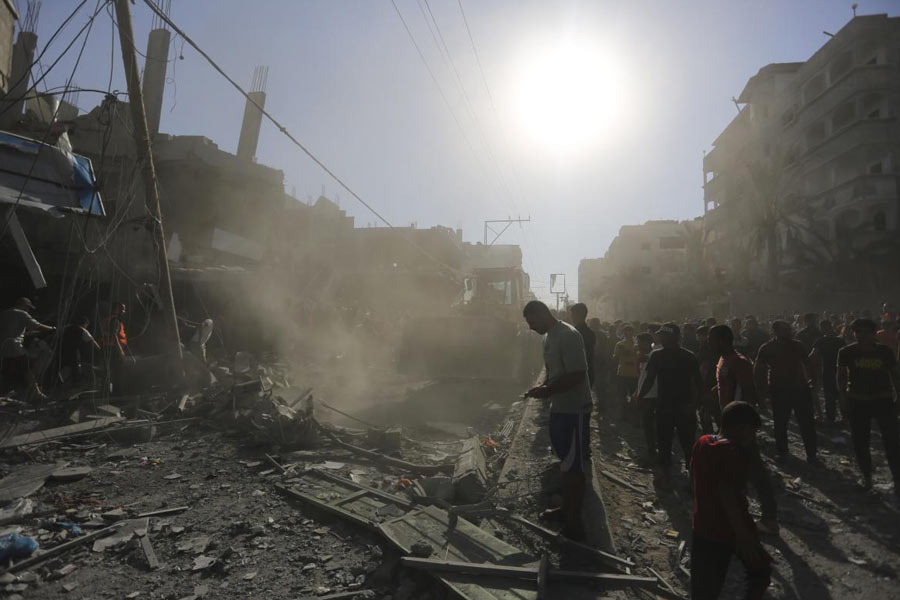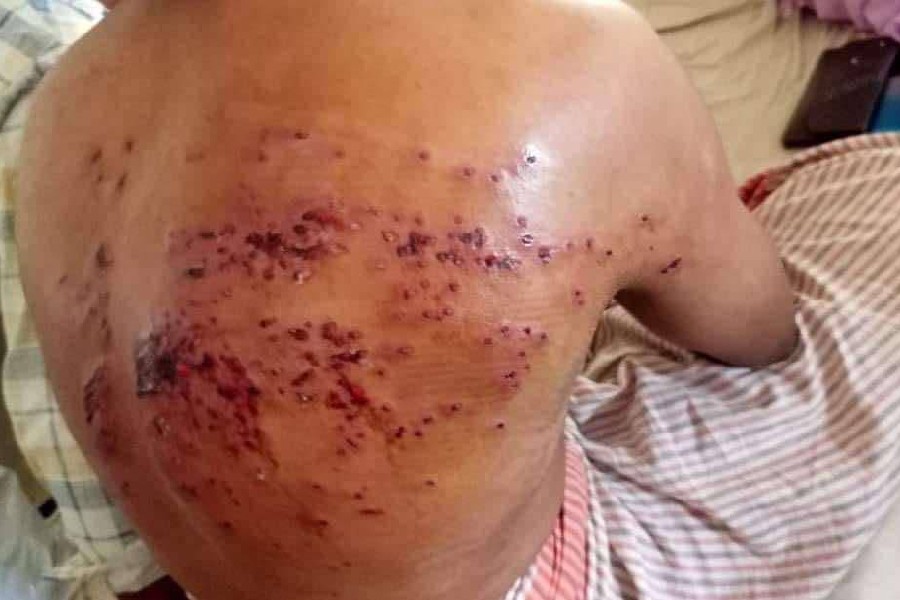Israeli forces backed by fighter jets and drones carried out a second ground raid into Gaza in as many days and struck targets on the outskirts of Gaza City, the military said Friday, as it prepares for a widely expected ground invasion of the Hamas-ruled territory.
US warplanes meanwhile struck targets in eastern Syria that the Pentagon said were linked to Iran's Revolutionary Guard after a string of attacks on US forces by Iran-backed fighters, adding to the already high regional tensions fueled by the three-week-old Gaza war.
The Palestinian death toll has soared past 7,000 as Israel has carried out waves of devastating airstrikes in response to a bloody Hamas incursion into southern Israel on Oct 7. The Health Ministry in Gaza, which tracks the toll, released a detailed list of names and ID numbers on Thursday. The toll includes more than 2,900 minors and more than 1,500 women.
The overall number of deaths far exceeds the combined toll of all four previous wars between Israel and Hamas, estimated at around 4,000.
More than 1,400 people in Israel, mostly civilians, were slain during the initial Hamas attack, according to the Israeli government. Hamas is holding at least 229 captives inside Gaza, including men, women, children and older adults.
The airstrikes have flattened entire neighborhoods, causing a level of death and destruction unseen in the last four wars between Israel and Hamas. Over a million people have fled their homes, with many heeding Israeli orders to evacuate to the south, despite continuing Israeli strikes across the sealed-off territory.
The humanitarian crisis sparked by the war and the Israeli siege has sparked protests across the region, and more demonstrations were expected later Friday after weekly Muslim prayers.
The military said ground forces raided inside Gaza, striking dozens of militant targets over the past 24 hours. It said aircraft and artillery bombed targets in Shijaiyah, a neighborhood on the outskirts of Gaza City that was the scene of a bloody urban battle in the 2014 Gaza war.
The military said the soldiers exited the territory without suffering any casualties. It reported an earlier raid into northern Gaza early Thursday, saying ground forces battled militants and struck anti-tank missile firing positions in an operation that lasted hours.
Rear Adm. Daniel Hagari, an Israeli military spokesman, said the raids enable forces to “uncover the enemy,” to kill militants and to remove explosives and launch pads. The aim is “to prepare the ground for the next stages of the war,” he added.
The damage to Gaza from nearly three weeks of bombardment showed in satellite photos of several locations taken before the war and again in recent days.
Entire rows of residential buildings simply disappear in the photos, reduced to smears of dust and rubble. A complex of 13 high-rises by the sea was pounded to dust near Gaza City's al-Shati refugee camp, leaving only a few tottering bits of facade. Just down the street, hardly anything remained in what had been a neighborhood of low-built homes on winding lanes, according to the photos by Maxar Technologies.
The military says it only strikes militant targets and accuses Hamas of operating among civilians in an attempt to protect its fighters. The Israeli military said an airstrike killed one of two masterminds of the Oct. 7 massacre, Shadi Barud, the head of Hamas' intelligence unit.
Palestinian militants have fired thousands of rockets into Israel since the war began.
Hamas' military wing said Thursday that Israeli bombardment has so far killed about 50 of the hostages. There was no immediate comment from Israeli officials, who have denied previous, similar claims.
The conflict has threatened to ignite a wider war across the region.
Hezbollah, an Iranian-backed ally of Hamas in Lebanon, has repeatedly traded fire with Israel along the border, and Israel has carried out airstrikes targeting Iran-linked groups in Syria. The United States has sent two aircraft carrier strike groups to the region, along with additional fighter jets and other weaponry and personnel, in part to deter Iran and its allies from entering the war on the side of Hamas.
U.S. Defense Secretary Lloyd Austin said the strikes in eastern Syria were “a response to a series of ongoing and mostly unsuccessful attacks against U.S. personnel in Iraq and Syria by Iranian-backed militia groups that began on Oct. 17.”
He said President Joe Biden directed the narrowly tailored strikes “to make clear that the United States will not tolerate such attacks and will defend itself, its personnel and its interests.” He added that the operation was separate and distinct from Israel's war against Hamas.
Syrian opposition activists in the area said the two locations are associated with Iranian arms shipments to militant groups in the region, and had been evacuated ahead of the strikes. There were no immediate reports of casualties.
Egyptian state media reported that six people were lightly wounded when a rocket slammed into a medical building in the town of Taba, on the border with Israel. It was not immediately known who fired the projectile.
Hagari, the Israeli military spokesperson, said “an aerial threat was identified in the area of the Red Sea,” which appeared to be the source of the blast in Egypt. He said fighter jets were dispatched to the area and that Israel, Egypt and the U.S. were tightening their defenses in the region.
Last week, a U.S. Navy destroyer in the northern Red Sea shot down three cruise missiles and several drones launched toward Israel by Iran-backed Houthi rebels in northern Yemen.
In Gaza, supplies of food, medicine and fuel for powering emergency generators are running low. The U.N. agency for Palestinian refugees, which provides basic services to hundreds of thousands of people, including operating schools turned into shelters, has said it may run out of fuel within days.
Gaza's sole power station shut down for lack of fuel days after the start of the war, and Israel has barred all fuel deliveries, saying it believes Hamas would steal them for military purposes.
About 1.4 million of Gaza's 2.3 million residents have fled their homes, with nearly half of them crowding into U.N. shelters. Hundreds of thousands remain in northern Gaza, despite Israel ordering them to evacuate to the south and saying that those who remain might be considered “accomplices” of Hamas.
In recent days, Israel has let more than 70 trucks with aid enter from Egypt through the Rafah crossing, the only entry point into Gaza not controlled by Israel. But aid workers say the convoys meet only a tiny fraction of the territory's mounting humanitarian needs. Before the war, an average of 500 trucks entered Gaza each day.
The U.S. has been working with other mediators to send in more humanitarian aid, but Israel is demanding strict screening to make sure none falls into the hands of Hamas. The U.S. says Hamas has meanwhile refused to open the Gaza side of the Rafah crossing to let hundreds of foreign passport holders leave.











